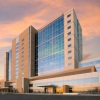DOTmed Industry Sector Report: Nuclear Medicine
by Barbara Kram, Editor | July 08, 2009

Philips GEMINI TF
Big Bore PET/CT
Big Bore PET/CT
This report originally appeared in the June 2009 issue of DOTmed Business News
Molecular imaging is proving to be a problem-solver in all three dimensions of medicine-clinical practice, research, and public health policy. As the U.S. weighs health care reform options this specialty is a perfect fit, combining clinical utility with cost-effectiveness.
"The new reforms are going to help nuclear medicine if properly used," said Henry Wagner, M.D., professor emeritus at Johns Hopkins Bloomberg School of Public Health. Dr. Wagner briefs the Society of Nuclear Medicine (SNM) each year about trends in the specialty. His theme this year is the role of molecular imaging in creating a new, smarter health care system. While policy wonks focus on administrative improvements, Dr. Wagner has the clinical perspective on trends like electronic medical records. "Recording and analyzing the data from patients' electronic records will really improve patient care and decrease costs," he said. "If we really want to know what works, we can mine electronic records on the population level. In so doing, molecular imaging will come out on top as a way to improve care and reduce expenditures."


 In his 33rd annual report to colleagues at this year's SNM meeting, Dr. Wagner will cite cases in point that demonstrate the value of molecular imaging. For instance, a study from the University of Zurich (BA Herzog) demonstrates that the use of SPECT is more than justified in its ability to diagnose coronary disease and identify appropriate intervention.
In his 33rd annual report to colleagues at this year's SNM meeting, Dr. Wagner will cite cases in point that demonstrate the value of molecular imaging. For instance, a study from the University of Zurich (BA Herzog) demonstrates that the use of SPECT is more than justified in its ability to diagnose coronary disease and identify appropriate intervention.
"The nuclear medicine studies show that coronary angiography, which is an invasive procedure, could have been avoided in 60% of patients that had it....a great [potential] savings in costs," Dr. Wagner noted. "As the economic aspect of medicine is coming to the forefront right now, it really puts nuclear medicine or molecular imaging into a tremendously important position."
Add to the promise of the field its application in two of the most prevalent conditions-heart disease and cancer - and the potential of molecular imaging to improve patient care seems limitless.
New Technologies Propel the Specialty Forward
Generally, SPECT/CT has a largely cardiac focus, with PET/CT more utilized in cancer, although studies are done with both techniques in both fields. Both technologies are on the cutting edge in their main disciplines where molecular imaging holds the promise of earlier intervention, informing more appropriate treatment options and demonstrating treatment response faster.
Molecular imaging is proving to be a problem-solver in all three dimensions of medicine-clinical practice, research, and public health policy. As the U.S. weighs health care reform options this specialty is a perfect fit, combining clinical utility with cost-effectiveness.
"The new reforms are going to help nuclear medicine if properly used," said Henry Wagner, M.D., professor emeritus at Johns Hopkins Bloomberg School of Public Health. Dr. Wagner briefs the Society of Nuclear Medicine (SNM) each year about trends in the specialty. His theme this year is the role of molecular imaging in creating a new, smarter health care system. While policy wonks focus on administrative improvements, Dr. Wagner has the clinical perspective on trends like electronic medical records. "Recording and analyzing the data from patients' electronic records will really improve patient care and decrease costs," he said. "If we really want to know what works, we can mine electronic records on the population level. In so doing, molecular imaging will come out on top as a way to improve care and reduce expenditures."
Training and education based on your needs
Stay up to date with the latest training to fix, troubleshoot, and maintain your critical care devices. GE HealthCare offers multiple training formats to empower teams and expand knowledge, saving you time and money

"The nuclear medicine studies show that coronary angiography, which is an invasive procedure, could have been avoided in 60% of patients that had it....a great [potential] savings in costs," Dr. Wagner noted. "As the economic aspect of medicine is coming to the forefront right now, it really puts nuclear medicine or molecular imaging into a tremendously important position."
Add to the promise of the field its application in two of the most prevalent conditions-heart disease and cancer - and the potential of molecular imaging to improve patient care seems limitless.
New Technologies Propel the Specialty Forward
Generally, SPECT/CT has a largely cardiac focus, with PET/CT more utilized in cancer, although studies are done with both techniques in both fields. Both technologies are on the cutting edge in their main disciplines where molecular imaging holds the promise of earlier intervention, informing more appropriate treatment options and demonstrating treatment response faster.









